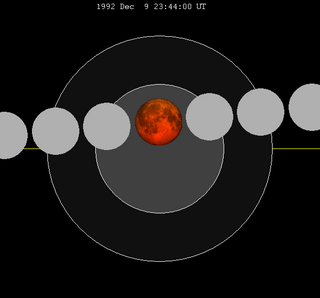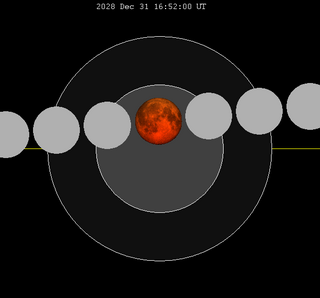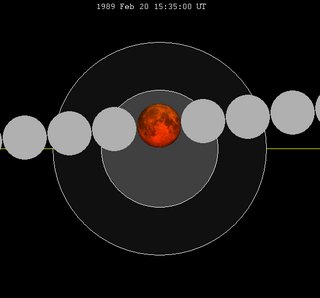Visibility
It was completely visible over Europe, Africa, Asia, Australia, Pacific, western North America, seen rising over Europe and Africa and setting over the central Pacific Ocean and North America.
| Total eclipse | |||||||||||||||||
| Date | 29 November 1974 | ||||||||||||||||
|---|---|---|---|---|---|---|---|---|---|---|---|---|---|---|---|---|---|
| Gamma | 0.30540 | ||||||||||||||||
| Magnitude | 1.28961 | ||||||||||||||||
| Saros cycle | 125 (46 of 72) | ||||||||||||||||
| Totality | 75 minutes, 45 seconds | ||||||||||||||||
| Partiality | 208 minutes, 58.7 seconds | ||||||||||||||||
| Penumbral | 333 minutes, 11.6 seconds | ||||||||||||||||
| |||||||||||||||||
A total lunar eclipse took place on Friday, November 29, 1974, the second of two lunar eclipses in 1974. The Moon was plunged into darkness for 1 hour, 15 minutes and 45 seconds, in a deep total eclipse which saw the Moon 28.961% of its diameter inside the Earth's umbral shadow. The visual effect of this depends on the state of the Earth's atmosphere, but the Moon may have been stained a deep red colour. The partial eclipse lasted for 3 hours, 28 minutes and 58.7 seconds in total. The penumbral eclipse lasted for 5 hours, 33 minutes and 11.6 seconds. The partial eclipse lasted for 3 hours, 28 minutes and 58.7 seconds. The total eclipse lasted for 1 hour, 15 minutes and 45 seconds. Occurring only 3.6 days before perigee (Perigee on Tuesday, December 3, 1974), the Moon's apparent diameter was 1.4% larger than average.
It was completely visible over Europe, Africa, Asia, Australia, Pacific, western North America, seen rising over Europe and Africa and setting over the central Pacific Ocean and North America.
| Lunar eclipse series sets from 1973–1976 | ||||||||
|---|---|---|---|---|---|---|---|---|
| Ascending node | Descending node | |||||||
| Saros | Date Viewing | Type Chart | Gamma | Saros | Date Viewing | Type Chart | Gamma | |
| 110 | 1973 Jun 15  | Penumbral | −1.32166 | 115 | 1973 Dec 10  | Partial | 0.96441 | |
| 120 | 1974 Jun 04  | Partial | −0.54887 | 125 | 1974 Nov 29  | Total | 0.30540 | |
| 130 | 1975 May 25  | Total | 0.23674 | 135 | 1975 Nov 18  | Total | −0.41343 | |
| 140 | 1976 May 13  | Partial | 0.95860 | 145 | 1976 Nov 06  | Penumbral | −1.12760 | |
| Last set | 1973 Jul 15 | Last set | 1973 Jan 18 | |||||
| Next set | 1977 Apr 04 | Next set | 1977 Sep 27 | |||||
Lunar saros series 125, repeating every 18 years and 11 days, has 26 total lunar eclipses. The first was on June 17, 1704 and the last will be on March 19, 2155 . The longest totality occurrence of this series (7th) was on August 22, 1812 when totality lasted one hour and 42 minutes. [1]
This is the 16th of 26 total lunar eclipses in series 125. The previous occurrence was on November 18, 1956 and the next will occur on December 9, 1992.
A lunar eclipse will be preceded and followed by solar eclipses by 9 years and 5.5 days (a half saros). [2] This lunar eclipse is related to two annular solar eclipses of Solar Saros 132.
| November 23, 1965 | December 4, 1983 |
|---|---|
 |  |

A total lunar eclipse occurred from 5:27 to 11:06 UTC on 21 December 2010, coinciding with the date of the Winter solstice in the Northern Hemisphere and Summer solstice in the Southern Hemisphere. It was visible in its entirety as a total lunar eclipse in North and South America, Iceland, Ireland, Britain and northern Scandinavia.

A total lunar eclipse took place on Thursday 28 October 2004, the second of two total lunar eclipses in 2004, the first being on 4 May 2004. It was the first lunar eclipse to take place during a World Series game, which when seen from Busch Memorial Stadium in St, Louis, Missouri, provided a surreal sight on the night the Boston Red Sox won their first World Series in 86 years to end the Curse of the Bambino. Occurring 5.6 days before apogee, the Moon's apparent diameter was smaller. The moon was 10.1 days after perigee and 5.6 days before apogee.

A total lunar eclipse took place on Friday, February 9, 1990, the first of two lunar eclipses in 1990.

A total lunar eclipse took place on Wednesday, December 9, 1992, the second of two lunar eclipses in 1992, the first was a partial lunar eclipse on Monday, June 15.

A total lunar eclipse will take place on Sunday, December 31, 2028. It will occur during a blue moon and is the first such eclipse to happen on New Year's Eve and New Year's Day since December 2009, and the first total lunar eclipse on New Year's Day in history. The next such eclipse will be on December 2047.

A penumbral lunar eclipse took place on Sunday 26 May 2002, the first of three lunar eclipses in 2002.

A total lunar eclipse took place on Sunday 16 July 2000, the second of two total lunar eclipses in 2000.

A total lunar eclipse took place on Monday, February 20, 1989, the first of two total lunar eclipses in 1989.

A total lunar eclipse will take place on August 7, 2036. The southern tip of the Moon will pass through the center of the Earth's shadow. This is the last central lunar eclipse of Saros cycle 129.

A total lunar eclipse will take place between Monday and Tuesday, June 25-26, 2029. A central total eclipse lasting 1 hour and 41 minutes 53 seconds will plunge the full Moon into deep darkness, as it passes right through the centre of the Earth's umbral shadow. While the visual effect of a total eclipse is variable, the Moon may be stained a deep orange or red color at maximum eclipse. It will be able to be seen from most of the Americas, Western Europe and Africa. The partial eclipse will last for 3 hours and 39 minutes 32 seconds in total.
A total lunar eclipse took place on Tuesday, July 6, 1982, the second of three total lunar eclipses in 1982, and the only one that was in the descending node. A dramatic total eclipse lasting 1 hour and 46 minutes plunged the full Moon into deep darkness, as it passed right through the centre of the Earth's umbral shadow. While the visual effect of a total eclipse is variable, the Moon may have been stained a deep orange or red colour at maximum eclipse. This was a great spectacle for everyone who saw it. The partial eclipse lasted for 3 hours and 56 minutes in total.
A penumbral lunar eclipse took place on Tuesday, May 15, 1984, the first of three lunar eclipses in 1984. This was a deep penumbral eclipse, with the southern limb of the Moon close to the Earth's shadow.

A partial lunar eclipse occurred on 19 November 2021. The eclipse occurred towards a micromoon. This was the longest partial lunar eclipse since 18 February 1440, and the longest until 8 February, 2669; however, many eclipses, including the November 2022 lunar eclipse, have a longer period of umbral contact at next to 3 hours 40 minutes. It was often referred to as a "Beaver Blood Moon" although not technically fulfilling the criteria for a true blood moon (totality).
A total lunar eclipse will take place on Friday, March 14, 2025, the first of two total lunar eclipses in 2025. The Moon will take place near apogee during this eclipse, making it appear smaller than usual. The second eclipse will take place on 7-8 September 2025, happening near perigee. Occurring only 3.4 days before apogee, the Moon's apparent diameter will be 5.4% smaller than average.
A partial lunar eclipse took place on Tuesday, June 4, 1974, the first of two lunar eclipses in 1974. The Moon was strikingly shadowed in this deep partial eclipse which lasted 3 hours and 14 minutes, with 82.695% of the Moon in darkness at maximum. Occuring 4.5 days before apogee, the Moon's apparent diameter was 4.4% smaller than average.

A total lunar eclipse took place on Wednesday, October 18, 1967, the second of two total lunar eclipses in 1967, the first being on April 24, 1967.
A total lunar eclipse took place at the Moon's descending node of the orbit on Tuesday, May 24, 1910 with an umbral eclipse magnitude of 1.09503. A total lunar eclipse takes place when the Earth comes between the Sun and the Moon and its shadow covers the Moon. Eclipse watchers can see the Moon turn red when the eclipse reaches totality. Total eclipses of the Moon happen at Full Moon when the Sun, Earth, and Moon are aligned to form a line. The astronomical term for this type of alignment is syzygy, which comes from the Greek word for being paired together. The Moon does not have its own light but shines because its surface reflects the Sun's rays. During a total lunar eclipse, the Earth comes between the Sun and the Moon and blocks any direct sunlight from reaching the Moon. The Sun casts the Earth's shadow on the Moon's surface. A shallow total eclipse saw the Moon in relative darkness for 49 minutes and 29.5 seconds. The Moon was 9.503% of its diameter into the Earth's umbral shadow, and should have been significantly darkened. The partial eclipse lasted for 3 hours, 35 minutes and 22.9 seconds in total.

A total lunar eclipse will take place on August 28, 2072.

A total lunar eclipse will take place on September 8, 2090.

A partial lunar eclipse took place on Friday, April 23, 1948. A tiny bite out of the Moon may have been visible at maximum, though just exactly 2.3% of the Moon was shadowed in a partial eclipse which lasted for 34 minutes and 18 seconds. A shading across the moon from the Earth's penumbral shadow should have been visible at maximum eclipse.